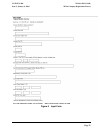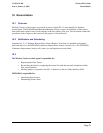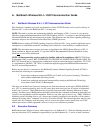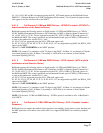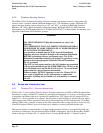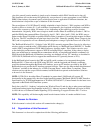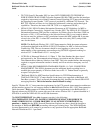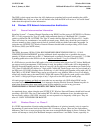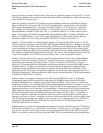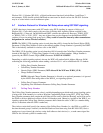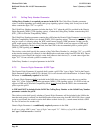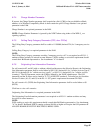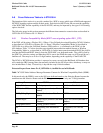
CG-EWCG-001 Wireless E911 Guide
Issue 3, January 6, 2004 BellSouth Wireless E9–1–1/SS7 Interconnection
Guide
view, this general location number is simply used to determine which PSAP should receive the call.
This document will use the term pANI generically, except where it is more appropriate to use ESRD or
ESRK. Other industry documents specify which precise term is applicable for different situations, but
that distinction is beyond the scope or intention of this document.
The second phase of 94-102 (Phase II, initially scheduled to begin October 1, 2001) requires each WSP to
be able to deliver a wireless 9-1-1 call with Phase I requirements, plus longitude and latitude coordinates
of the caller, accurate to within 150 meters or less, depending on the technology used for location
determination. Originally, WSPs were to begin to make wireless Phase II available by October 1, 2001 to
qualified PSAPs that requested Phase II service by April 1, 2001. After April 1, 2001, the WSPs were to
begin to make Phase II available to qualified PSAPs within six months of a receiving their request for Phase
II service. The FCC modified the original start date in late 2001. Generally speaking, Phase 2 began in late
2002, and it is expected to roll out continually until ubiquitous coverage is provided across all of the USA.
The "BellSouth Wireless E9-1-1 Solution" (aka: WLS911) currently supports Phase I service by allowing a
wireless carrier to send the caller’s CBN and the pANI directly to a BellSouth Nortel DMS E9-1-1 Tandem
switch (NDET) using dedicated FG-D Multi-Frequency signaling trunks. This Solution can also serve
as the underlying architecture to support a WSP in becoming Phase 2 compliant, if they chose to deploy
their own architecture in a manner that accommodates delivery of longitude and latitude coordinates to a
PSAP through the BellSouth ALI database, once they are obtained over an "E2" interface, as described in
J-STD-036-A (BellSouth will also support the modification of E2 generally known as E2+).
In the BellSouth hybrid scenario the CBN and pANI would continue to be transported through the
BellSouth E9-1-1 Network to the PSAP using WLS911, and the longitude and latitude coordinates
would be obtained through the BellSouth ALI database, across an E2 interface provided by the WSP.
BellSouth does not provide the E2 interface transport facilities. There are also other technical/architectural
"Solutions" available in the industry for a WSP to become Phase 1 and/or Phase 2 compliant. Those
solutions are beyond the scope of this document, but BellSouth does permit such alternative Solutions
to be used via our Network.
NOTE: J-STD-036-A describes Phase II standards in greater detail. BellSouth will support E2
functionality in the manner fully described in the Intrado document "BellSouth SR/ALI to MPC Interface
Specifications for TCP/IP Implementation of TIA/EIA/J-STD-036 E2" (Contact Intrado for the latest issue
supported on BellSouth ALI Data Base systems.
Partly due to the E9-1-1 industry’s migration into Wireless Phase II, and also due to other recent and future
(anticipated) technological developments in the E9-1-1 industry in general, BellSouth will begin (in 2004)
to allow the use of Common Channel Signaling (CCS) technology to support Wireless E9-1-1 service.
NOTE: This capability will be thoroughly tested in each instance before it is made available for use.
A.4 Reason for Revision
If this document is revised, this section will summarize the change(s).
A.5 Organization of this Document
This document is to be used in conjunction with the following publications:
Page 79



